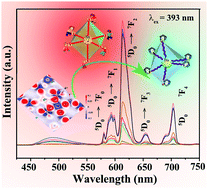A useful valence-alterable optical probe for the prediction of material characteristics based on theoretical calculations†
Abstract
The controllable design and precise modulation of the functional properties of materials based on theoretical calculations has always been the goal of materials researchers. Through the comparative analysis of theoretical calculations and experimental phenomena, physical properties, including optical properties, electrical conductivity, and dielectric properties, can be further comprehended. In this work, on the basis of the first-principles calculations of many inorganic compounds, we selected BaSnSi3O9 (BSSO) as the research focus and found that it contained two cationic sites with completely different electronic characteristics. Among them, the electron density of cations at the Ba site shows obvious localization characteristics, whereas the Sn site shows strong interaction with the surrounding environment. This distinct difference in electronic characteristics is very beneficial to the research and design of materials with functional properties. When functional ions are introduced into Ba sites, the relatively complete independence of these ions will be maintained. That is, if an ion with multiple stable valence states is introduced at the Ba site, it will exhibit the coexistence of multiple valence states. However, if an ion is introduced at the Sn site, this ion will lose its independence and exhibit strong interaction with the surrounding crystal field environment. The rare earth element europium (Eu) with two stable divalent and trivalent valence states in its normal state was chosen as a probe to verify the theoretical predictions in this work. According to the calculation results, when Eu occupied the Ba site, the spectrum simultaneously showed the luminescence of Eu3+ and Eu2+, and had a larger luminescence quenching concentration when the influence of defects was ignored. When Eu occupied the Sn lattice site, it only showed the luminescence of Eu3+, and had a lower luminescence quenching concentration due to the attractive effect that the surrounding O atoms had on the Eu electrons. Our research indicates that the experimental results are consistent with the theoretical predictions. This paper analyzes the important role of Eu optical probes in terms of investigating their physical mechanisms and optical properties in detail. It will provide valuable inspiration for theoretical calculations to guide the design of materials and the modulation of their functional properties.



 Please wait while we load your content...
Please wait while we load your content...